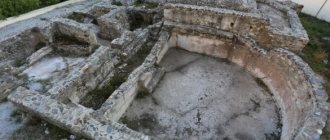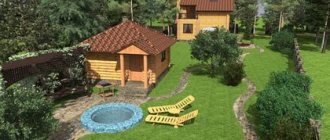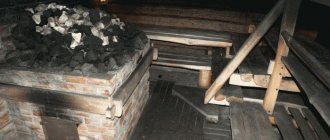Judging by ancient Greek images and archaeological excavations, we can say for sure that water procedures occupied an important part in the life of the Greeks. At the same time, water had not only hygienic, but also sacred and mystical significance.
The Greek bath in ancient times had a sacred and mystical meaning.
Baths in Ancient Greece were called laconiums. Most likely, this name is associated with the region of Laconia, where Sparta was located. It is not known for certain when the first Greek baths began to be built, but scientists suggest that it was the 5th century BC. It was at this time that the historian Herodotus compared Roman baths and Greek laconium in his works. Thanks to this fact, it can be argued that baths in the territory of Ancient Greece at that time were already quite common.
Laconicum and ancient philosophy
Hellas was a country where there was a cult of a healthy body. Only in a healthy body can a healthy spirit and divine philosophy live. Only in such a country could Hippocrates appear; only in Ancient Greece could his recommendations on the use of a variety of water procedures become so popular. Numerous excavations of baths and bath complexes confirm Homer’s statements about the love of the Greeks for water procedures.
The Greeks regarded bathing as a sacred act. They sat in the bathtub, unless Hippocrates advised lying down, with their feet in a special recess, and spent no time in it less than the recommended time. They used soaps made from goat fat and ash, aromatic oils, scrapers, and washcloths. The Greeks associated clean skin with physical and mental health.
The first baths appeared in the city of Laconia, in Sparta. These were round rooms with a fireplace in the center. The stove heated natural stones, with the help of tongs additional stones, heated in another room, were brought into the room by slaves, so the temperature was raised to 60°-70°C. The stones were occasionally watered to achieve a humidity of 15-20%.
Laconicum was part of the gymnasium, a sports facility for training and ablutions, and was a means of relaxation and rest after physical exertion. The gymnasium included a palaestra, a place for competitions, and an exedra, a place for philosophical conversations.
The Greek laconium differs from the Roman baths in the modesty of its decoration. The heart of the Greek bath, the room in which the ancient Hellenes steamed, was a rotunda with a truncated dome on top. There was a hole inside the dome that closed when the soaring process was in progress. But the main difference between laconicum and terma was their purpose.
The Greeks viewed the bathhouse exclusively as a medical, hygienic procedure associated with spiritual and bodily cleansing, but not as entertainment. And the Romans embodied in their baths all the thirst for spectacle inherent in the ancient descendants of Romulus and Remus.
Baths of the peoples of the world. Baths of Greece
The construction of baths is the responsibility of the state! Plato
The epic of Ancient Greece tells in great detail the history of Greek baths.
Alexander the Great, while carrying out a military campaign against Egypt, learned about the baths there, he was amazed by them and really liked them. Upon returning home, the first order was to build Greek baths that would not be inferior in comfort to Egyptian baths. The order was carried out, and in the shortest possible time, so-called eastern-type baths, that is, baths with heated floors, were built throughout Ancient Greece.
Baths were widespread in Hellas. The Greek bathhouse received its name “laconicum” from the city of Laconica, from where bathing procedures spread throughout Greece.
The ancient Hellenes, primarily the Spartans, the founders of the bathing ritual, proclaimed the cult of a powerful body and a strong spirit. Men and boys doused themselves with cold water to maintain physical health - bathing in warm water was not recognized and was considered a sign of weakness, which was excusable only for women.
However, it was the Greeks who put into practice the idea of combining hot water and steam and learned to set and control the required temperature conditions of air and water in the bathhouse.
The ancient Greek bathhouse was a round room lined with hewn stones. The Greek bath was heated using an open hearth, which was located in the middle of the room, as in the Roman thermal baths. After sweating in the steam room, the Greeks doused themselves with water from a jug, took baths or swam in the pool. The temperature contrast of excellent heat and cool water provided the skin with cleanliness and tone.
Special copper devices were used in the laconicum - shears, intended for body cleansing and massage. After bathing and bathing, it was customary to rub the body with oil and other incense and be sure to put on a clean tunic.
For the Greeks, the laconicum was not only an institution intended for hygienic procedures, but also a center of public culture. The Greek bath was originally an integral part of the sports complex (gymnasium) and served as a means of restoring strength after strenuous physical exercise.
Device
Why did the Greeks use the hemispherical shape for their baths? It contributed to the rapid heating of the room, the heat was distributed evenly, the stones that were in the steam room and additionally brought in kept the temperature at a constant level without changes. The chimney, in the form of an opening in a cone-shaped roof, worked properly, in accordance with physical laws, during the heating of the stove, then closed so that the heat did not escape.
Hellas, water cult
The Laconicum included a small pool or bath. There were also several tanks with water of different temperatures for swimming. Men used only cold water, considering warm water unworthy of themselves. It was believed that warm water was for women.
There were no water pipes in the laconiums; water was brought in by hand, scooped up and drained just as easily. Marble lining of trestle beds and sun loungers was considered important; they were located in close proximity to the source of heat and themselves became its emitter, enriching the air with minerals of natural origin.
The principle of the Greek bath is similar to the Russian one, using a heater, draft, and also a method of steam generation. The only difference is in the temperature level, the Greeks preferred moderate heat, while in the Russian bathhouse the heat is strong and the temperatures are high.
Like Roman baths, Hellenic laconicums were places of meetings and conversations. In additional rooms for massage and relaxation, philosophical and business conversations were held, pressing issues were resolved, and acquaintances were made.
Ancient laconiums: what were they like?
Traditional Greek laconiums were built in the form of a stone hemisphere. This shape made it possible to warm up the interior of the bathhouse quickly and evenly. Heating was provided by an open hearth, which was located in the center of the steam room and heated with charcoal. In the hearth, heat-accumulating stones were used to maintain heat and steam for a long time. They splashed water on them to increase humidity and, thanks to them, enjoyed long-lasting warmth. Almost the same as in a modern stove!
The chimney in the Greek bath also existed - in the form of a hole with a lid in the domed ceiling. During bathing procedures, the lid was closed, but during heating it was opened using bronze chains.
Every laconium, even the smallest family one, always had a bath or shallow pool. In large baths there were several containers for bathing, with water of different temperatures. Men accepted only cold water; women could relax in warm water. The disadvantage of baths in ancient Greece was the lack of drainage. Each time, after taking water procedures, water was scooped out of the pools manually.
The internal surfaces of the Greek bath, including sun loungers, baths and pools, were lined with stone or tiles. After lighting the hearth, they also became a source of soft heat.
In Ancient Greece, laconicum was visited not only to maintain body cleanliness. People came here to communicate, make useful contacts, and even decide political affairs. It was a kind of club of interests. Most often, the Greek bath was part of a gymnasium - a large sports complex, where there was everything for maintaining the health of the body and cultural pastime: massage and medical rooms, relaxation rooms, competition grounds, gyms, etc.
Features of the procedure
The functionality of the Greek bath came first. After a competition or training, the Greeks, covered in oil, dusty, and sweaty, rushed to bathe and cleanse their skin. The bath conditions contributed to the effective cleansing of the skin. Steamed with the help of scrapers and washcloths, the Greeks practiced hygiene, fulfilling the requirements of the goddess of beauty and health Hygieia, daughter of Asclepius.
Laconium ruins
The cleansing process alternated with the hardening process. The steam room was followed by contrasting procedures of a cold bath, in which the Hellenes could sit for quite a long time. This was followed by a massage and a pleasant process in all respects, when the body was anointed with oils. A Hellene who had undergone a similar purification procedure was considered admitted to the exedra for sublime conversations.
A distinctive feature of the Greek bath is the uniform heating of the body; the warmth that embraces a person from all sides does not injure him and allows him to stay in the steam room for a long time.
Russian bath
Now it's time to tell a story about our Russian bathhouse. I am sure that she is synonymous with the Russian soul. We cannot be imagined without her; she accompanies us all our lives.
Our bathhouse is fundamentally different and different from all known bathhouses. We, like many others, have private and public baths. The difference is that they are radically different from each other.
Not a single people in the world has heated or is heated in a black bathhouse. And private Russian baths were heated only in black. It is an undeniable fact that there are many baths, but only Russians have bath brooms.
Bathhouse in Rus'
Our black bath is a separate topic of conversation, a long and interesting conversation. I will try to tell my story of a black bathhouse in the next article, since I myself went to such a bathhouse throughout my childhood.
Read more information about different countries on the website https://nashaotdelka.ru/
The benefits and harms of Greek laconicum
The conditions of a Greek bath are extremely beneficial for the human body, without radical temperature changes, without extreme heat, without an ice bath - the gentle conditions have no contraindications for use. Anyone, old and young, healthy and sick, can take a steam bath in Laconicum, unless there are individual contraindications.
The Greek bath is useful because:
- removes toxins and waste;
- relieves pain symptoms;
- accelerates metabolic processes;
- calms the nervous system;
- stabilizes blood pressure;
- relieves insomnia and depression;
- treats the musculoskeletal system.
Conditions that are comfortable for the body relieve cardiovascular stress and do not put the heart at risk. A person does not sweat immediately; sweating begins after 20-25 minutes of exposure. The person calms down, becomes relaxed, and relaxation begins.
Laconicum is perhaps the only bathhouse that patients with chronic diseases can visit.
- Egyptian bath
- Greek bath
- Roman bath terma
- Turkish bath
- Georgian bath
- Japanese bath
- Tibetan bath
- African bath
- Bath in Western Europe
- Icelandic bath
- Finnish sauna
- Russian bath
CHAPTER 1
Historical information about the bathhouse
It is difficult to say when a person first began to use bath procedures. But it can be argued that the bathhouse appeared as a natural product of human life. By improving the techniques of using fire, people discovered the possibility of using hot water and steam. There is an opinion that the bathhouse appeared among almost all nations at the same time. This was stated, for example, by the ancient Greek historian Herodotus (484–425 BC).
If the prototype of a steam bath is considered to be heated stones on which water falls, forming steam, then the appearance of the bath can be attributed to the Stone Age. One legend says that the prototype of the bathhouse and steam room are underground hot springs. Primitive hunters could rest near such a source, warm themselves with warm steam and feel a surge of strength, relief from pain and joy from the cleanliness of the body.
According to another legend, the bathhouse appeared several thousand years ago after the invention of a closed hearth-stove and earthenware. When it rained, drops of water fell on the hot stones of the hearth in the dwelling of primitive man. The steam enveloped people in a pleasant warmth, and they began to pour water on the hot stones, increasing the effect of the steam.
Thus, the first family bathhouse was a dwelling with a fireplace in the middle.
It is believed that the first public bathhouse was a ritual hut with such a fireplace. The Scythian tribes who lived in Ukraine and Russia had similar baths. These baths were described by the ancient Greek historian Herodotus (circa 488–225 BC). The Scythians tied inclined poles with their upper ends and covered them with woolen felt. A boiler with water was installed in the middle of the yurt. During a ritual dance, the Scythians threw hot stones into a cauldron of cold water. They also threw in hemp seeds, which added flavor to the steam. In these healing steams, our ancestors steamed and whipped with brooms just like we do. And then they doused themselves and washed themselves with water.
An analogue of such a bath can be found among modern American Indians. Their temezcal baths look like a low hut (1.5 m high) in the shape of a cone. Inside the hut, soil is selected and compacted. A depression is made in the center of the hut, where stones heated over a fire are placed. Then they close the hut and in the dark they splash cold water on the hot stones. Such a hut is set up near a river or stream in order to cool down after warming up.
In the countries of the Ancient East (India, China, Egypt) comfortable baths were already built. The first mentions of them date back to the 13th century BC. e.
Egyptian bath
Baths in Ancient Egypt were widespread and acted as a hospital, since almost all diseases were treated with water. These baths were accessible even to a poor person.
At the excavation site of an ancient Egyptian city, archaeologists discovered the remains of a bathhouse, which consisted of two floors. On the upper floor there were large stone benches, which were heated from the lower floor. Visitors lay on these stones, and the steamers anointed their bodies with healing potions, rubbed them, and massaged them. There was a hole in the stone through which steam came out from below. The Egyptians widely used medicinal inhalations in their baths. Instead of soap, they used a paste of beeswax and water.
In the middle of the room on the top floor there was a small pool for contrasting water treatments. There was a room for gymnastics, a healing room in which archaeologists found medical instruments.
A drain was made in the floor of the bathhouse for water, which went into the general drain of the city. This drainage system served as a kind of central heating for the city.
The traditions of the ancient Egyptian bath became the basis for Turkish baths and Roman baths.
Greek bath
The ancient Greek epic described bath procedures in detail. Alexander the Great (356–323 BC) during his campaign against Egypt learned about the Egyptian baths, which he really liked. Returning to his homeland, he ordered the construction of the same comfortable baths as in Egypt. He distributed oriental-type baths with heated floors in Ancient Greece.
The first baths in Ancient Greece were called laconicums, since they were built by the Lacedaemonians. The bathhouse had a round shape. Unlike the Egyptian baths, the Greek bath was heated by heat from an open fire in the middle of the room. There was also a cold water pool and baths. But there was no drainage. Water was bailed out from the baths and swimming pool.
The ancient Greek baths were also a hospital in which both rich and poor people got rid of many ailments. As they spread, the baths became richer and more comfortable. They were built from expensive materials and decorated with precious stones. Such baths were available only to noble residents of the city.
Roman bath terma
In Ancient Rome, the art of building baths reached its greatest flowering. Baths for ordinary people and luxurious thermal bath complexes were built here. In the ancient Roman baths, which accommodated 2,500 people, there were many rooms for bath procedures (warming, washing, cooling, bathing), many fountains, pools and baths, a complex heating system heated the floor and heated water for washing. Already in those days they used alternating immersion in hot and cold water, which is now called contrast dousing.
During the excavations of Pompeii, the remains of baths were discovered, not very large in size, but with many rooms. In front of the entrance to the bathhouse there was an area for sports and gymnastics or a park in which one could exercise or simply relax.
The Pompeian baths began with an elongated room, decorated with stucco, mosaic floors, sculptural and mosaic images of Neptune. This room served as a dressing room, with shelves for clothes on the walls.
From the dressing room-apodyterium, the bathhouse visitor entered a room with a domed blue ceiling and walls painted with images of plants, animals and birds. There were two small pools with cold and hot water. Being in such a room, a person found himself as if in a fairy garden, which enhanced the impression of the pleasant influence of water.
From the locker room it was possible to get into another room, a kind of steam room with a stove, like in our bathhouse. But they really took a steam bath in the next room with wet steam (caldarium), which was periodically refreshed through open windows. In the caldariums, the walls and floors were heated with hot air in a pipe system (the thermal baths were heated with oil). There was also a shower in the form of a fountain and many basins for washing. Those who wished could take a bath. Interestingly, water from the ceiling was collected through special grooves and discharged into the general sewer system.
Small baths were heated with wood. The Romans knew how to process firewood in such a way that it did not smoke. To do this, the bark was removed from the firewood, soaked, dried over the fire, and then soaked in olive oil sediment or simply dried over the fire.
Noble and rich Romans often visited the baths. Interestingly, when greeting each other, they asked: “How are you sweating?” The ancients considered visiting a bathhouse a most pleasant pastime, shared with friends, a means of healing and distraction from daily worries. In addition to recreation and treatment of many diseases, sports competitions, debates, and various tournaments were held here. Roman baths had rooms for massage, sports exercises, relaxation, reading, theatrical performances, art exhibitions, and trade. Water was delivered to these baths through a pipeline. About 800 thousand liters of water were used daily for the needs of the baths. The baths of Karkalla, named after the emperor who reigned from 211 to 217 AD, were especially famous. e.
The opening of the baths was announced by drumming. The Romans left many things and went to the bathhouse, which began with a spacious vestibule. From here we went into a large sweating room (tepidarium). The bathhouse had rooms with dry and wet steam, where the Romans stayed for no more than 10 minutes and moved to another room with pools of hot and cold water.
In the next room they were doing skin cleansing and massage. For cleaning, special scrapers made of wood or ivory were used. The Romans washed themselves with fine sand, which was delivered from the banks of the Nile, and soap made from goat fat and ash. The bath attendants performed all the necessary procedures: cleansing, massage, haircut, cutting calluses, removing excess hair from the skin, shaving, even minor operations. Massage with rubbing with healing and aromatic substances was especially popular.
The Roman rulers did not skimp on the construction of baths. For their construction, expensive and rare materials were brought, which cannot be found even in temples and palaces. The imagination of the architects knew no bounds. The baths were decorated with entire systems of fountains, waterfalls, hanging gardens and swing baths, sculptural compositions, and paintings. The dishes and basins were made of silver and gold. The motto of the noble Romans were the words: “Hunting, playing, having fun, going to the baths means living!”
Turkish bath
In Arab countries, the countries of the Middle East, Central Asia, and South-Eastern Europe, baths became widespread, combining some of the features of the construction of Roman baths with local traditions. In the eastern baths, the floors were heated to 50–60 °C, and steam came from them. Stone vaults of furnaces or boilers with boiling water sometimes served as an additional source of steam. It was possible to walk on the hot floors of such baths only in wooden sandals.
The Turkish baths resembled a palm in their plan. The entrance to the bathhouse (the crook of the wrist) served as a dressing room. This room prepared the visitor for the bath procedure, since the air temperature here was already increased (up to 34 °C). By the way, the visitors were not completely naked; their thighs were tied with a towel. A large hall (the palm itself) with a pool in the middle and rock-loungers around it. Both the floors and the sunbeds were heated. After the visitor had a good steam, having visited all five niches (phalanxes of the fingers) with a temperature of 70 to 100 ° C, he lay down with his stomach on a stone and sweated. Special employees skillfully performed massage, “tormenting” the body in every possible way, starting from the forehead and ending with the feet. At the same time, the person did not feel pain, but only enjoyed. In addition, in the bathhouse they removed excess hair, shaved, cut off calluses, and painted their palms and feet with henna.
Only after this did the washing begin. First, the stratum corneum along with dirt was removed with a hard washcloth. And then the clean skin was washed with a mild soap solution.
The last procedure was swimming in the pool (it was possible to swim alternately in warm and cold water).
Residents of the East, both poor and rich, returning from a tiring journey, having finished hard work, wanting to recover from the fear or excessive pleasure they had suffered, went to the bathhouse. They noticed that bath procedures and regular ablutions saved from many diseases, and therefore they considered the presence of good baths to be the main advantage of a particular city. In order to preserve a long memory of themselves, eastern rulers built not only mosques and caravanserais, but also did not skimp on spacious, rich baths.
Turkish baths, which combined ancient baths with the traditions of Central Asia and the ancient culture of China and India, had great fame. This is stated in the work “The Canon of Medical Science”, which was written by Avicenna, based on the works of doctors of Ancient Greece and Rome, China and India. In this book he proposes the hygienic and medicinal uses of water.
In his treatise “On the Bath” Avicenna wrote:
“—A bathhouse is necessary primarily for people who need moderate warmth and hydration of the body. To do this, there is no need to stay in the bathhouse for too long, but just take a bath until the skin turns red. As soon as the redness begins to disappear, the bath should be left.
- A person engaged in physical exercise should not rush to the bathhouse until he has completely rested.
- Everyone washing in the bathhouse should enter it gradually and not stand in a hot room until they feel faint.
- Those who want to gain weight should go to the bathhouse after eating, unless such a person is inclined to form blockages. To protect against this, you need to use mint. Anyone who wants to lose weight and get rid of toxins must go to the bathhouse hungry and stay there for a long time. If a person’s goal is simply to maintain health, he should go to the bathhouse after eating, but after digesting what is in his stomach. A person with a hot nature, with a predominance of bile, needs to eat something light before the bath (bread soaked in fruit water). It is also undesirable for such a person to enter the steam room.
— It is dangerous to drink both too hot and too cold drinks in the bathhouse. When leaving the bathhouse, you cannot expose your head and body.
- Thus, the benefits of the bath are to calm, open pores, give the body shine, and absorb excess. The bath dilutes harmful thick juices, attracts nutrients to the outer surface of the body and relieves fatigue.
— A bathhouse can acquire additional advantages depending on the water that is used in it. If the water contains soda or sulfur, or it is sea water, or ashes, or if water with laurel is used, then the bath will dissolve and soften. This bath eliminates looseness and obesity.
- Cuprous, ferruginous, and salty waters help against diseases caused by cold and damp nature. They are indicated for joint pain, gout, asthma, and kidney disease. A bath with such water accelerates the healing of fractures and is beneficial for furunculosis and ulcers. Cuprous water is good for the mouth, tongue, and ear diseases. Water with iron helps with diseases of the stomach and spleen. Salt water has a beneficial effect on people with diseases of the nervous system and bloating.
— Baths with alum and vitriol water help with pulmonary tuberculosis, bleeding from the anus, rectal prolapse, causeless miscarriage, excessive sweating and swelling.
— Sulfur water is indicated for various nervous disorders, spasms, and cleanses the body of acne, blemishes, and freckles. Baths with such water well dissolve excess (waste) accumulated in the body, and especially in the liver and spleen. But swimming in this water reduces your appetite.”
Georgian bath
On the territory of Georgia, even during the times of the ancient state of Urartu, baths were built on the basis of hot springs and had natural steam. The attraction of Tbilisi (“the warm city”) has always been the sulfur thermal baths. Everyone who came to this city tried to visit them. Among the guests was Alexander Sergeevich Pushkin, who described the bath ritual in detail.
“The Persian led me into the baths: a hot, iron-sulfur spring flowed into a deep bath carved into the rock. I have never seen anything more luxurious than the Tiflis baths either in Russia or Turkey. I will describe them in detail.
The owner left me in the care of a Tatar bathhouse attendant. I must confess that he was without a nose; this did not stop him from being a master of his craft. Hassan (as the noseless Tatar was called) began by laying me out on the warm stone floor; after which he began to break my limbs, pull out my joints, and hit me hard with his fist; I did not feel the slightest pain, but an amazing relief. (Asian bathhouse attendants sometimes become delighted, jump on your shoulders, slide their legs along your thighs and dance on their backs in a squat, e sempre bene.) After this, he rubbed me for a long time with a woolen mitten and, having splashed me heavily with water, began to wash me with a soapy linen bubble. The feeling is inexplicable: hot soap pours over you like air! ...a woolen mitten and a linen bladder must certainly be accepted in a Russian bath: connoisseurs will be grateful for such an innovation.
After the bubble, Hassan let me go to the bath; and that was the end of the ceremony.”
Mountain water from hot springs flowed into Georgian baths through ceramic pipes. This water filled marble-lined pools located under a domed roof, through which soft light entered the room. The baths were located in grottoes, illuminated by torches. The Georgians invited guests to their baths, held holidays there, and sang long, sad songs in many voices.
In ancient times, Georgian baths worked around the clock, many people spent the whole day in the bath. Women often visited the bathhouse, so they were distinguished by their health, beauty and remained attractive for a long time.
Restored according to old traditions, Tbilisi sulfur thermal baths are still successfully used for bathing, relaxation and treatment of various diseases and attract tourists.
Japanese bath
The Japanese family bathhouse is unique - furo. This kind of bathhouse originated a long time ago. According to Buddhist laws, making soap was prohibited in Japan (for this you need to kill animals), so the Japanese washed themselves in very hot water. The damp climate of Japan also contributed to the fact that in winter people visited hot water baths three times a week.
Furo was placed in a large wooden barrel with hot water. A seat was placed inside the barrel. The man in it sat reclining, immersing his entire body, with the exception of his chest, in hot water. You had to take such a bath by putting a damp cap soaked in cold water on your head. This barrel was placed on the stove. We were in hot water for a short time, about 5 minutes. Then a massage was performed. To do this, they put hard mittens on their hands. After the massage, we wiped ourselves dry and wrapped ourselves in a warm robe to relax. To increase sweating, they wrapped themselves in warm blankets and lay on the couch.
The modern Japanese bathhouse is called sento. Visiting a sento is a universal pleasure and aesthetic pleasure for the Japanese. Like everything in Japan, the bathhouse has a picturesque and exotic appearance. There are artificial rocks and small waterfalls on the walls.
It is a shallow pool with running hot water for five to six people. The water temperature reaches 50 °C. The water in the pool is changed regularly. Before taking a bath, they wash in a fenced off adjacent room, sitting on wooden grates on the floor. There is no shower. Soaping and rubbing the body is accompanied by periodic dousing with water.
Sento for the Japanese is a source of health. Japanese doctors have determined that this bath relieves stress, rheumatic pain, stimulates the activity of the cardiovascular system and kidneys, and activates metabolism. By visiting the bathhouse, the Japanese make their body resistant to many colds and infectious diseases.
Japan is rich in such thermal waters. Japanese furo hot baths are based on their use.
The sawdust bath is also revered in Japan, when the person washing is immersed in a wooden barrel with sawdust heated to 50 °C for 8–12 minutes. The most healing are considered to be cedar sawdust with the addition of rice bran and a crushed mass of up to 60 different medicinal herbs.
In modern conditions of a city apartment, you can also arrange a Japanese bath. To do this, pour water at a temperature of 37 °C into the bath. While in the water, gradually, over 12–15 minutes, bring the temperature to 41–43 °C. After warming up in hot water, you need to get out of the bath, put on a dry terry robe and wrap yourself in a warm blanket. You need to sweat like this for about an hour. You can drink weak hot tea with raspberries or honey. In conclusion, you need to dry yourself and go to bed, wrapped in blankets, for 2 hours.
A homemade Japanese bath cleanses the body of toxins, strengthening the body's defenses. It is especially useful during the onset of a cold. And in case of chronic diseases, when the body does not resist enough, Japanese hyperthermic baths can awaken its natural forces to fight.
Tibetan bath
The medical practice of hydrotherapy of the ancient physicians of Tibet is very interesting. She has absorbed all the best from the healing experience and practice of Indian and Chinese doctors. Basically, hydrotherapy for a variety of diseases was reduced to the use of baths and various compresses.
The Tibetan bathhouse is unique. For this procedure, a hole was dug 50–70 cm deep and wide enough to allow an adult to sit in the hole. They burned birch wood at the bottom of this pit. Then two more portions of birch firewood were added. They threw old bones onto the resulting layer of coals and waited for them to burn. A portion of fresh birch firewood was placed on the resulting ashes and covered with cedar (spruce or pine) paws.
Then they sat a person on the pine needles, covered his head and hovered as long as he could stand it. Then he left the pit and lay down to rest, wrapped up warmly, for 2 hours.
After this, he was wiped dry and rubbed with healing ointments, while performing a massage of the whole body.
African bath
The peoples of Africa widely used hydrotherapy in their rituals and mystical rites. The water here was considered sacred. In all countries where sand was available, they dug a hole in it according to the size of the body, and built a fire in the hole from small branches. Having removed the remains of the fire, they poured dry heated sand and applied leaves and herbs useful for the body, depending on what hurt someone. Sometimes, instead of a fire, the pit was doused with boiling water.
They lay down in a hole, covered themselves with medicinal herbs on top and raked sand hot in the sun onto their bodies. The time spent in such a bath was determined by the well-being of the patient being treated.
Bath in Western Europe
It was not only in Ancient Greece, Rome and the Middle East that people used hot springs for healing. After the Crusaders' campaigns in Western Europe in the 14th–16th centuries, eastern baths also began to be built. They were called Roman and Turkish. But soon the baths were banned as obscene establishments. This was one of the reasons for epidemics of terrible diseases. The use of thermal springs and the tradition of hydrotherapy gradually declined. The ancient Roman baths, their meaning, traditions, and methods of treatment were forgotten. And only in the Renaissance, when the development of culture, science, and medicine resumed, did they remember about hydrotherapy. However, due to epidemics of plague and cholera in Europe, treatment with water was unsafe.
It was only in the 19th century that baths appeared again in Europe. Doctors again began to use the healing properties of water in their practice in the form of baths, saunas, and various water procedures.
Icelandic bath
Since 1856, the Icelandic bathhouse, which was a simplified oriental bathhouse with a shower and a dry, hot steam room with heated walls, became widespread. Channels were made in one of the walls of the steam room to discharge exhaust air. The bath procedure consisted of preliminary warming up for half an hour in a not too hot room, sweating (about 15 minutes) in the steam room, massage and showering.
Icelandic baths and pools, like Georgian ones, are based on natural hot springs. Houses and greenhouses, in which even pineapples are grown, are heated with water from these sources. The capital of Iceland, Reykjavik, is the most environmentally friendly city in the world, as it is not polluted by waste from the combustion of coal, oil and gas. Translated from Icelandic, the word “Reykjavik” means “cove of steam”.
Finnish sauna
In recent decades, Finnish baths - saunas - have become widespread in Western European countries and the countries of North and South America. Traditional wooden saunas were designed the same as Russian village baths. Bath procedures differed only in that the Finns loved drier steam, which was easier to tolerate than wet steam. It is believed that in traditional Russian baths they mainly steam with wet steam with a moisture content of up to 60–70% at a temperature of 50–60 °C and certainly with a broom, and in traditional Finnish saunas they steam with dry steam with a moisture content of 10–30% at temperature 70–100 °C and without a broom. However, it should be noted that in Russian baths, amateurs also first sweat while sitting on a shelf in dry heat, warm up the body, and then begin to release steam and use brooms, if necessary, cooling the bath by opening an vent or door. To keep the bathhouse dry, the stones on the stove are sufficiently heated and hot water is supplied to them in small portions.
In turn, the Finns also cannot do without a broom, which is the simplest and most excellent means of massage. Of course, when using a broom, the humidity in the steam room increases, and accordingly the temperature must be lower, otherwise skin burns are possible. That is why in modern baths only steam rooms are usually called saunas, where the air humidity is 5–15% (less often 10–30%) and the temperature is 80–140 °C, although in reality a sauna is a bathhouse as a whole, including washing rooms, recreation rooms, etc.
Traditional saunas, like Russian baths, are “black” and “white”. Some lovers believe that real saunas and Russian baths are “black”, with a smoky aroma. However, for people who are not keen on exotic and smoky aroma, the only advantage of smoky baths is their cost-effectiveness.
To build a stove-stove without a chimney, half as much brick is required, and to fire it, half as much wood is consumed as for a stove with a chimney. Therefore, it is advisable to build such baths only in areas where it is difficult to obtain bricks and fuel.
It should be noted that the wide spread of Finnish baths was facilitated by widespread advertising, industrial production and export of prefabricated and block baths with the necessary equipment, the organization of the scientific and technical society "Sauna" in Finland, the publication of the magazine "Sauna", the creation of the museum "Sauna" and the joint-stock company " Puutalo”, engaged in the production and construction of saunas. Finnish experience in the construction and operation of family saunas is of interest to everyone. It should be noted that in our country, developers of family saunas in rural estates and garden plots use the same techniques, principles and rules as in Finland when building family saunas. The only difference is in industrial construction methods and in some of the materials and workpieces used.
So, from the depths of centuries two types of baths have reached us: hot-air baths - Roman, Turkish, Finnish; steam, or Russian. The main difference between them is that in a hot air bath the air is dry, while in a Russian bath it is mixed with wet steam.
Russian bath
Historical information about the Russian bathhouse begins with the use of steam and hot water by the Scythian tribes who lived in Russia.
About 800–900 years ago, in the cities of Rus', Volga Bulgaria and other European territories, stone baths were already built, combining local traditions with eastern ones. In 1090, in Pereslavl, on the orders of Bishop Ephraim, who later became the Metropolitan of Kyiv, a large stone bathhouse was built. On the site of the city of Bulgar, the capital of Volga Bulgaria, the remains of five stone baths were discovered in the 9th–14th centuries. But still, the main population in these parts used wooden baths.
In its original form, the Russian bathhouse was a log hut with a low ceiling, where there was a stove-stove, a high bench - shelves for steaming, and a low bench for washing while sitting. The stove-stove did not have a chimney and was heated “black”. The smoke from it was released into the open door and the vent - a hole in the wall above the shelf. After finishing the fire, the door and the vent were closed and the bathhouse was allowed to “languish” and “ripen” for some time until the walls of the bathhouse evenly warmed up and the coals burned out. Then the remaining coals were extinguished with water and, opening the doors for a short time, the bathhouse was ventilated from carbon monoxide (“fumes”). Water was heated on the stove or near the firebox in clay pots, and when tin buckets became widespread, in buckets. In a separate pot, lye was prepared - alkaline ash water, replacing soap, in another pot - an infusion of wormwood or other herbs with disinfectant and medicinal properties. Wooden ladles, buckets, and tubs were used for washing, and wooden barrels were used to store cold water. We undressed and dressed in an unheated dressing room.
The bathing procedure of Russians in the 17th century was described by the traveler Olearius in this way: “They, lying down on the shelves, order themselves to be beaten and rub their bodies with a hot birch broom... then, when they turn red from the heat and are exhausted to the point that they are no longer able to stay in the bathhouse, they run out of it naked, both men and women, and douse themselves with cold water, and in winter, having jumped out of the bathhouse, they roll in the snow, rub their bodies with it, as if with soap, and then, having cooled down in this way, again enter the hot bathhouse. Since their baths are usually built near rivers and streams, those who wash in them are thrown directly from the heat into the cold water.” Olearius says that “in all cities and villages they (in Russia) have many public and private baths, in which you will almost always find many people washing themselves.”
The famous historian N.I. Kostomarov, in essays on the home life and morals of the Russian people in the 16th and 17th centuries, points out that the bathhouse was the first need in home life, both for cleanliness, treatment, and for a kind of pleasure.
The first scientific work on the Russian bath was the work of the Portuguese doctor A. N. R. Sanches, who served in Russia for a long time. His book was published in many countries, including in 1774 in Russia under the title “On steam Russian baths, since they accompany the strengthening, preservation and restoration of health.” He finds it especially useful that in a Russian bath, steam is supplied every 5 minutes, renewing the atmosphere.
Public baths in Russia differed from family baths not only in size, but also in design. In some of them, the steam rooms were separated from the washing room. These were, apparently, the baths built in the 18th century by order of Tsar Alexei Mikhailovich.
In the 19th century and the beginning of the 20th century, “white” baths, where heater stoves had a chimney, became widespread. Such baths could be heated during washing, were less fire hazardous and did not have soot on the walls and ceiling. In some of them, the stoves were heated from a dressing room or a separate room. There were also bathhouses in which steam was produced by a steam boiler, and hot water by a hot water boiler installed in the boiler room.
Of the comfortable ancient baths, the most famous are the Sandunovsky and Central baths in Moscow. On the site of the modern Sandunovsky baths, built in 1896 and including 28 rooms (27 of them with steam rooms), there used to be stone baths built in 1806 by the Sandunovs, famous actors of the Petrovsky Theater at that time. The old Sandunov baths were distinguished by luxurious amenities, for example, they had mirrored lounges with soft sofas.
Russian baths aroused the interest of many foreign guests from the East and West. They were surprised by the tradition of Russian people to alternate the heat of the bath with swimming in an ice hole, dousing with cold water and wiping with snow.
But these are the hardening procedures that Russian people have always used to improve their health. The famous A.V. Suvorov, with the help of douches, rubdowns and physical exercises, strengthened his health so much that he was able to endure the military life of a warrior until a very old age.
In Russia, the bathhouse was part of human life. In a fairly harsh climate, a Russian steam bath with a stove warmed up and healed many diseases. Each locality, even each family, had its own traditions of using the bathhouse. Some washed with soap before going to the steam room, others simply doused themselves with water, and others considered it necessary to sweat thoroughly before washing.
During the Great Patriotic War, soldiers were saved from illnesses in hastily constructed bathhouses. For this they used dugouts (like distant ancestors), carriages, and buses. The soldier's ingenuity helped to build a stove without brick or stone, but only from heavy shell casings. The bathhouse was a reliable healer for the soldiers.
Nowadays, baths include not only steam rooms, baths, showers, swimming pools, but also various treatment rooms, rest rooms, cafeterias and other premises for sanitary, hygienic and cultural purposes. Although modern baths in big cities are not at all similar to those in which our grandfathers steamed, the principle of their effect on the body is the same as in traditional folk baths.
Table of contents
Greek bath today
It is not difficult to reproduce exactly the original conditions of the Greek laconicum today. A round or oval room is required with a stove-stove in the center, steam pumped by a steam generator to the required values, and massive stone sun loungers. Maintaining temperatures up to 75° and humidity up to 20% is also possible. As for contrasting procedures, you don’t need a massive pool, a bath or an ordinary font with heated water is enough.
Today you can find decent Greek baths. In large health complexes, salons, and fitness centers, it is practiced to create conditions for the harmony of the Greek bath. The cost per hour ranges from 1000 to 1500 rubles. Since a stay in a modern Greek bath requires at least 4 hours (a long stay in the steam room, a long stay in the pool and only then rest), the pleasure is expensive.
Modern Greek bath
Modern version
The body is warmed up evenly in such baths, so staying in it can be quite long.
Laconicum today is the name given to one of the types of saunas, which are characterized by finishing not with wood, but with natural stone or ceramic tiles. The main heat in a modern Greek bath comes from benches heated from the inside.
The temperature in such a bath is low, 65-75 degrees, the humidity is also low, 15-20%. The heat in the laconicum is easily tolerated, so you can stay in it much longer than in most other types of steam rooms and saunas. Warming up of the body here occurs slowly and evenly, so the circulatory system does not suffer from temperature changes and the skin does not suffer thermal stress. A person relaxing in a laconicum simply enjoys the warmth and peace. Profuse sweating occurs only 15-20 minutes after entering the steam room. Only then, simultaneously with sweat, toxins and waste begin to gently leave the body, nervous and muscle tension decreases, and metabolism normalizes.
The time you spend in such a bathhouse is practically unlimited; depending on your desires and capabilities, you can stay there for 10 minutes or a whole hour.
Modern Greek baths are often part of large-scale bath complexes, health centers, beauty salons and fitness clubs. They are also in demand in holiday homes and hotels. A private person can also become the owner of a Greek steam room. It is not too expensive, and more and more often builders, designers and planners are receiving orders for this type of construction.











